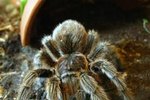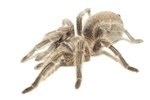
The goliath tarantula is the largest spider in the world, making it a tantalizing addition to arachnid lovers' pet collections. Although compelling as a specimen, Goliaths are some of the least friendly pet spiders. Their care requires the spider be provided with an appropriate habitat, fed well, regularly maintained and handled with care.
Housing the Giant
With a potential leg span of up to 12 inches, the goliath needs a larger enclosure than most tarantulas. A terrarium of at least 20 gallons is recommended. Both glass and plastic containers work well, as long as the lid is secure and there is some ventilation. These animals should be housed alone. Goliaths are burrowers that have been found in holes up to two feet deep, so a thick layer of substrate is required. Your spider will need at least enough substrate to fully bury itself -- about 6 inches minimum. Mulch and peat moss make good substrates. Artificial logs or flower pots make good hiding places, which a goliath also needs. A goliath prefers dark conditions and requires no lighting.
Feeding the Bird Eater
Although called the "bird eater" tarantula because it can take down large prey like birds, frogs and even snakes, T. blondi's diet should consist mainly of invertebrates such as crickets, larvae and cockroaches. Goliaths should be fed larger prey like mice about once a month. Never leave live food unattended in the enclosure with your tarantula, as the prey could harm your pet. If your bird eater refuses to eat, this could simply be a sign that it's about to molt, in which case all prey animals should be removed from the enclosure until the spider has completed its molt and its new exoskeleton is hardened. Only then is the tarantula ready to feed again. This could take one day or up to a few weeks. Your tarantula should be provided with a shallow dish of clean water at all times from which it can drink and the air can derive moisture.
Ongoing Maintenance
Theraphosa blondi originates from the rainforests of Venezuela, Suriname, French Guyana and Brazil. To replicate this tropical environment it needs weekly mistings with purified water and a heating pad to keep the enclosure between 78 and 82 degrees Fahrenheit. A combination thermometer/hydrometer will monitor the enclosure's temperature and humidity, which should be kept at about 80 percent. Any uneaten food should be removed from the enclosure within one day of feeding. All tarantulas molt throughout their lives, and during this time it's essential to leave the spider undisturbed and provide plenty of moisture. Molts happen less frequently as the tarantula ages. Goliaths are a long-term pet that live up to 20 years.
Handling the World's Largest Spider
As tarantulas go, the goliath is one of the least friendly. Although temperament varies among individuals, goliaths tend to be nervous and aggressive. Hissing, produced by rubbing together the leg bristles, is a typical warning this spider uses. It can be heard several yards away, so there's no mistaking this sign to back off. Goliaths are New World tarantulas, which means they also have urticating hairs to shed when in a bad mood. The spider will rear up its back end, facing it toward its attacker, and rub the hairs from its abdomen using a back leg. These hairs are highly irritating, especially when they come in contact with the eyes, nose or mouth. Bird eaters will also bite if provoked.
References
Resources
Photo Credits
-
Tom Brakefield/Stockbyte/Getty Images
Writer Bio
Madeline Masters works as a dog walker and professional writer. In the past she has worked as a fitness columnist, fundraising copywriter and news reporter. Masters won two Pennsylvania Newspaper Association Awards in 2009. She graduated from Elizabethtown College with a Bachelor of Arts in English.




